Capital Budgeting Process and Financial Analysis: Case Study Report
VerifiedAdded on 2023/01/07
|9
|2085
|78
Report
AI Summary
This report presents a comprehensive analysis of capital budgeting, focusing on a case study involving Valley University and a local bus service. The report begins with an introduction to capital budgeting, explaining its significance in long-term asset investments and financial decision-making. The main body of the report delves into the background of the case study, detailing the scenario where Valley University explores the possibility of providing a shuttle bus service. The report then outlines the capital budgeting process, including the identification of relevant information, the selection of appropriate analysis tools, and the evaluation of cash flows using methods like discounted cash flow (DCF) and net present value (NPV). Furthermore, the report reviews factors considered during capital budgeting, such as profit estimation and borrowing requirements. A critical review and evaluation of the case study are provided, including a table summarizing the financial analysis. The report concludes with recommendations for the university, such as utilizing capital budgeting techniques, adjusting fare prices, and providing incentives for drivers. The references section lists the sources consulted for this report.

Capital Budgeting
Paraphrase This Document
Need a fresh take? Get an instant paraphrase of this document with our AI Paraphraser

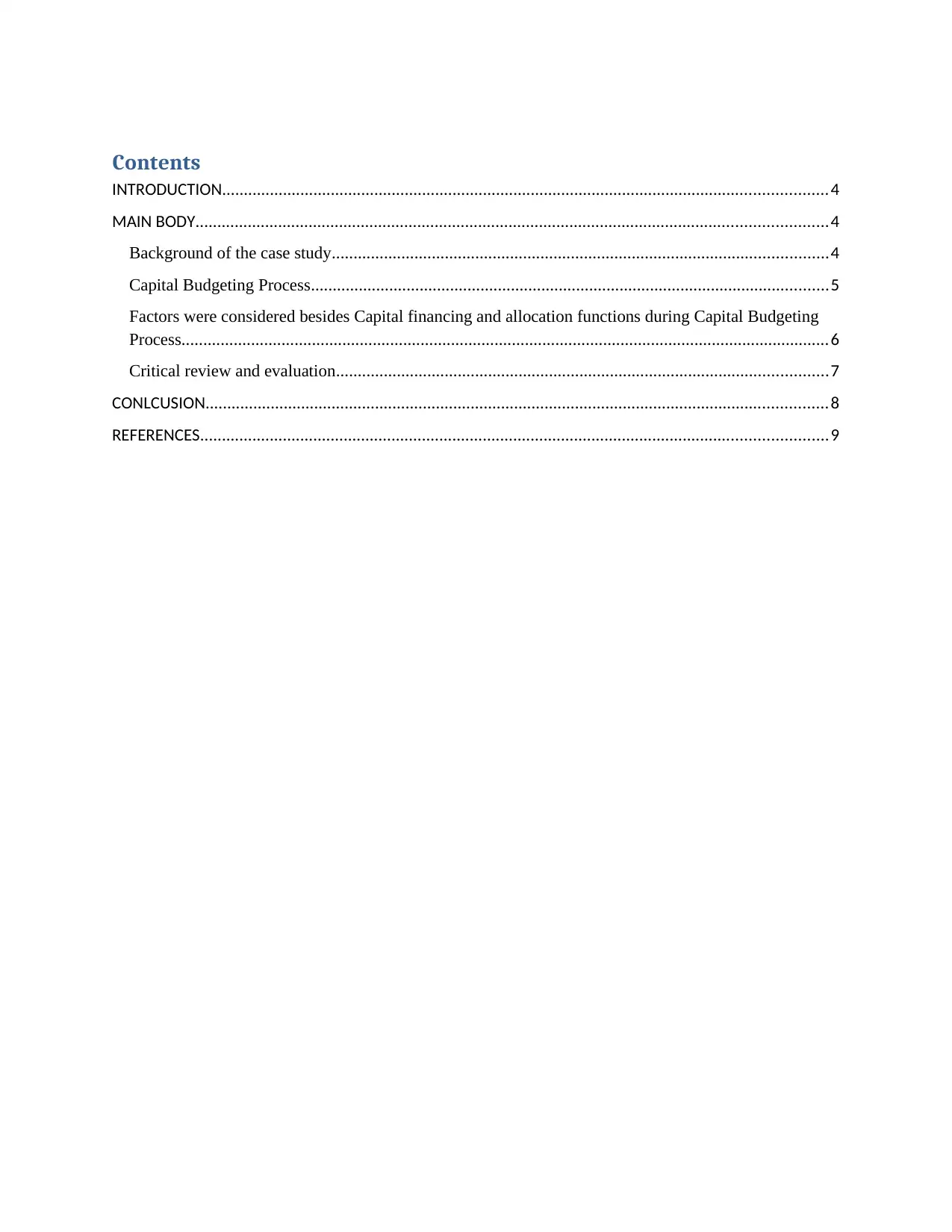
Contents
INTRODUCTION...........................................................................................................................................4
MAIN BODY.................................................................................................................................................4
Background of the case study..................................................................................................................4
Capital Budgeting Process.......................................................................................................................5
Factors were considered besides Capital financing and allocation functions during Capital Budgeting
Process.....................................................................................................................................................6
Critical review and evaluation.................................................................................................................7
CONLCUSION...............................................................................................................................................8
REFERENCES................................................................................................................................................9
INTRODUCTION...........................................................................................................................................4
MAIN BODY.................................................................................................................................................4
Background of the case study..................................................................................................................4
Capital Budgeting Process.......................................................................................................................5
Factors were considered besides Capital financing and allocation functions during Capital Budgeting
Process.....................................................................................................................................................6
Critical review and evaluation.................................................................................................................7
CONLCUSION...............................................................................................................................................8
REFERENCES................................................................................................................................................9
⊘ This is a preview!⊘
Do you want full access?
Subscribe today to unlock all pages.

Trusted by 1+ million students worldwide
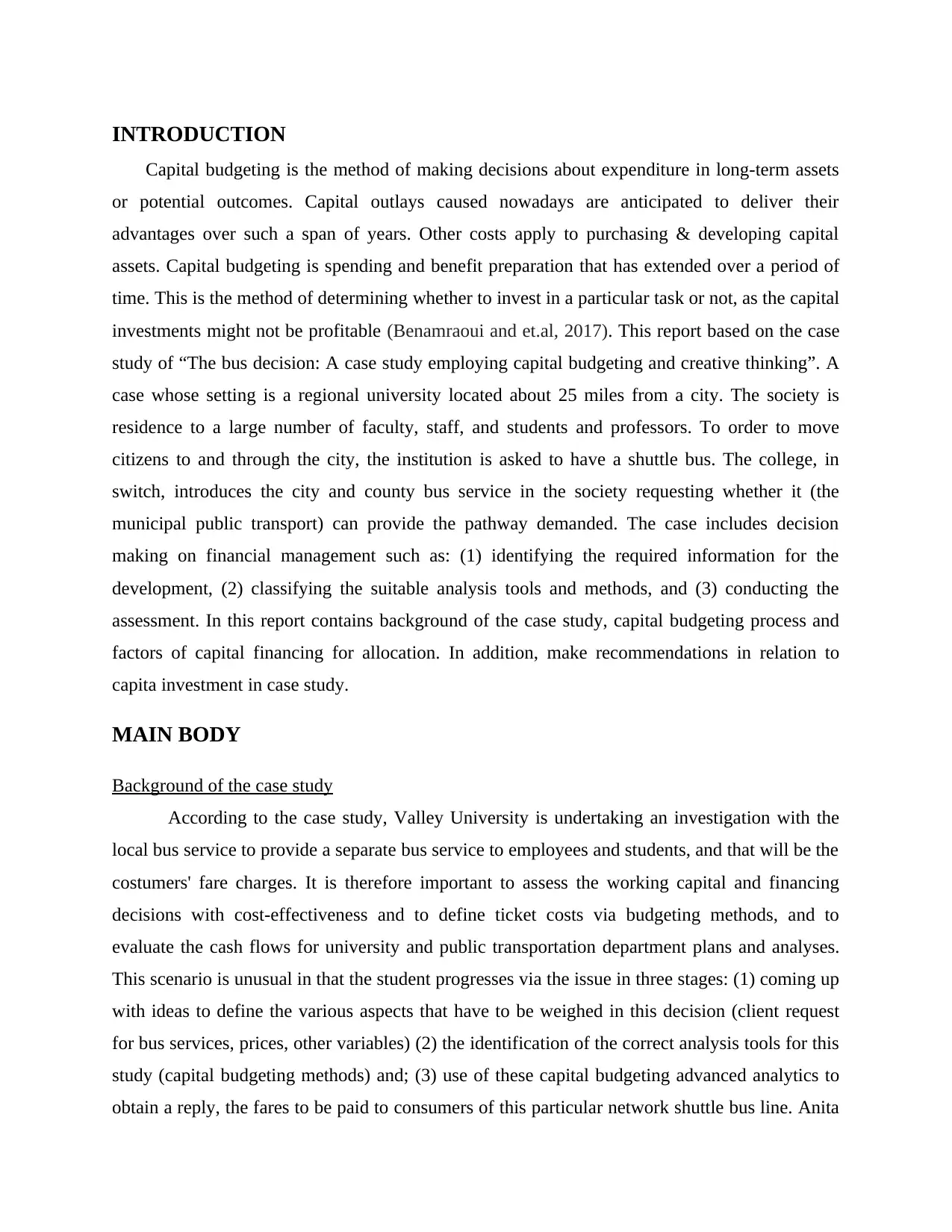
INTRODUCTION
Capital budgeting is the method of making decisions about expenditure in long-term assets
or potential outcomes. Capital outlays caused nowadays are anticipated to deliver their
advantages over such a span of years. Other costs apply to purchasing & developing capital
assets. Capital budgeting is spending and benefit preparation that has extended over a period of
time. This is the method of determining whether to invest in a particular task or not, as the capital
investments might not be profitable (Benamraoui and et.al, 2017). This report based on the case
study of “The bus decision: A case study employing capital budgeting and creative thinking”. A
case whose setting is a regional university located about 25 miles from a city. The society is
residence to a large number of faculty, staff, and students and professors. To order to move
citizens to and through the city, the institution is asked to have a shuttle bus. The college, in
switch, introduces the city and county bus service in the society requesting whether it (the
municipal public transport) can provide the pathway demanded. The case includes decision
making on financial management such as: (1) identifying the required information for the
development, (2) classifying the suitable analysis tools and methods, and (3) conducting the
assessment. In this report contains background of the case study, capital budgeting process and
factors of capital financing for allocation. In addition, make recommendations in relation to
capita investment in case study.
MAIN BODY
Background of the case study
According to the case study, Valley University is undertaking an investigation with the
local bus service to provide a separate bus service to employees and students, and that will be the
costumers' fare charges. It is therefore important to assess the working capital and financing
decisions with cost-effectiveness and to define ticket costs via budgeting methods, and to
evaluate the cash flows for university and public transportation department plans and analyses.
This scenario is unusual in that the student progresses via the issue in three stages: (1) coming up
with ideas to define the various aspects that have to be weighed in this decision (client request
for bus services, prices, other variables) (2) the identification of the correct analysis tools for this
study (capital budgeting methods) and; (3) use of these capital budgeting advanced analytics to
obtain a reply, the fares to be paid to consumers of this particular network shuttle bus line. Anita
Capital budgeting is the method of making decisions about expenditure in long-term assets
or potential outcomes. Capital outlays caused nowadays are anticipated to deliver their
advantages over such a span of years. Other costs apply to purchasing & developing capital
assets. Capital budgeting is spending and benefit preparation that has extended over a period of
time. This is the method of determining whether to invest in a particular task or not, as the capital
investments might not be profitable (Benamraoui and et.al, 2017). This report based on the case
study of “The bus decision: A case study employing capital budgeting and creative thinking”. A
case whose setting is a regional university located about 25 miles from a city. The society is
residence to a large number of faculty, staff, and students and professors. To order to move
citizens to and through the city, the institution is asked to have a shuttle bus. The college, in
switch, introduces the city and county bus service in the society requesting whether it (the
municipal public transport) can provide the pathway demanded. The case includes decision
making on financial management such as: (1) identifying the required information for the
development, (2) classifying the suitable analysis tools and methods, and (3) conducting the
assessment. In this report contains background of the case study, capital budgeting process and
factors of capital financing for allocation. In addition, make recommendations in relation to
capita investment in case study.
MAIN BODY
Background of the case study
According to the case study, Valley University is undertaking an investigation with the
local bus service to provide a separate bus service to employees and students, and that will be the
costumers' fare charges. It is therefore important to assess the working capital and financing
decisions with cost-effectiveness and to define ticket costs via budgeting methods, and to
evaluate the cash flows for university and public transportation department plans and analyses.
This scenario is unusual in that the student progresses via the issue in three stages: (1) coming up
with ideas to define the various aspects that have to be weighed in this decision (client request
for bus services, prices, other variables) (2) the identification of the correct analysis tools for this
study (capital budgeting methods) and; (3) use of these capital budgeting advanced analytics to
obtain a reply, the fares to be paid to consumers of this particular network shuttle bus line. Anita
Paraphrase This Document
Need a fresh take? Get an instant paraphrase of this document with our AI Paraphraser
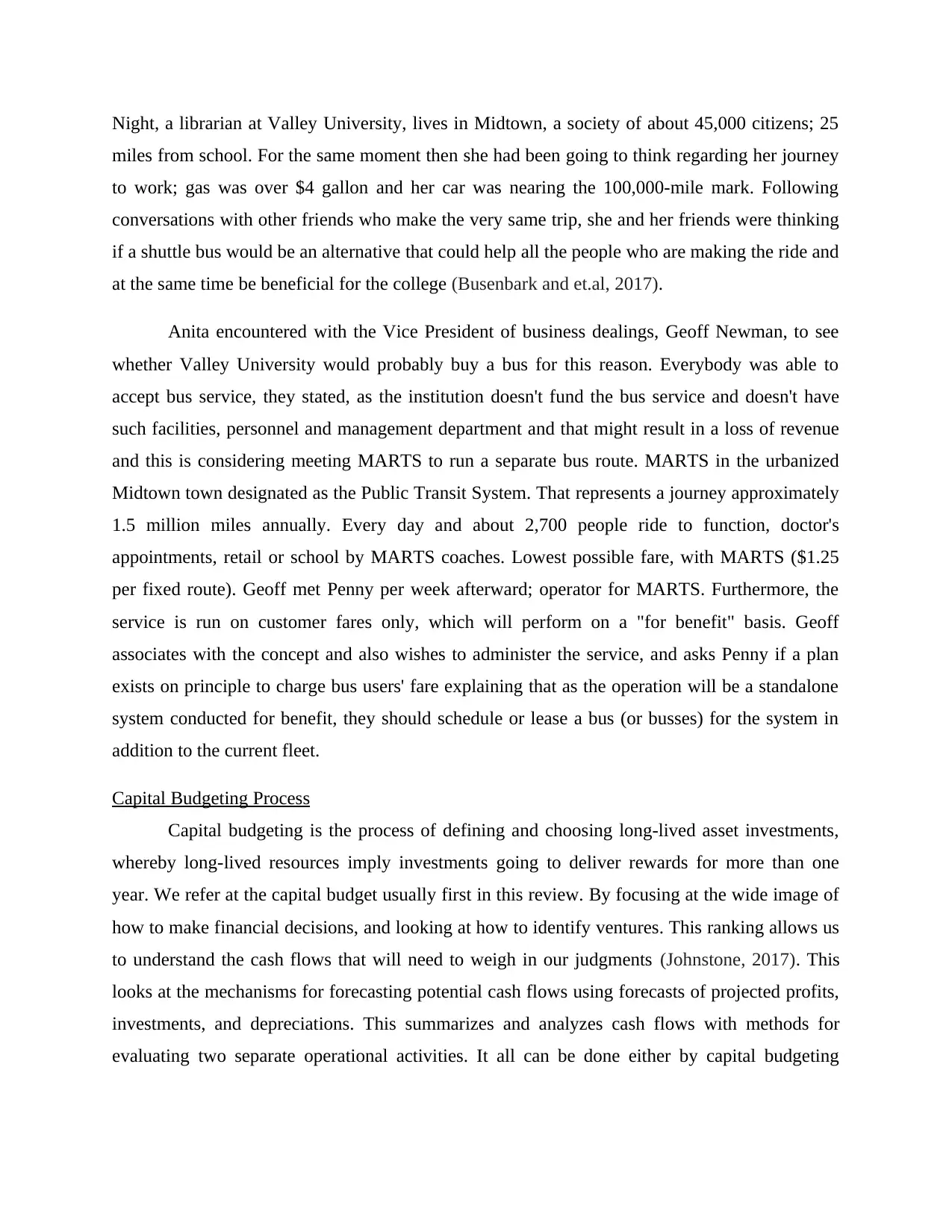
Night, a librarian at Valley University, lives in Midtown, a society of about 45,000 citizens; 25
miles from school. For the same moment then she had been going to think regarding her journey
to work; gas was over $4 gallon and her car was nearing the 100,000-mile mark. Following
conversations with other friends who make the very same trip, she and her friends were thinking
if a shuttle bus would be an alternative that could help all the people who are making the ride and
at the same time be beneficial for the college (Busenbark and et.al, 2017).
Anita encountered with the Vice President of business dealings, Geoff Newman, to see
whether Valley University would probably buy a bus for this reason. Everybody was able to
accept bus service, they stated, as the institution doesn't fund the bus service and doesn't have
such facilities, personnel and management department and that might result in a loss of revenue
and this is considering meeting MARTS to run a separate bus route. MARTS in the urbanized
Midtown town designated as the Public Transit System. That represents a journey approximately
1.5 million miles annually. Every day and about 2,700 people ride to function, doctor's
appointments, retail or school by MARTS coaches. Lowest possible fare, with MARTS ($1.25
per fixed route). Geoff met Penny per week afterward; operator for MARTS. Furthermore, the
service is run on customer fares only, which will perform on a "for benefit" basis. Geoff
associates with the concept and also wishes to administer the service, and asks Penny if a plan
exists on principle to charge bus users' fare explaining that as the operation will be a standalone
system conducted for benefit, they should schedule or lease a bus (or busses) for the system in
addition to the current fleet.
Capital Budgeting Process
Capital budgeting is the process of defining and choosing long-lived asset investments,
whereby long-lived resources imply investments going to deliver rewards for more than one
year. We refer at the capital budget usually first in this review. By focusing at the wide image of
how to make financial decisions, and looking at how to identify ventures. This ranking allows us
to understand the cash flows that will need to weigh in our judgments (Johnstone, 2017). This
looks at the mechanisms for forecasting potential cash flows using forecasts of projected profits,
investments, and depreciations. This summarizes and analyzes cash flows with methods for
evaluating two separate operational activities. It all can be done either by capital budgeting
miles from school. For the same moment then she had been going to think regarding her journey
to work; gas was over $4 gallon and her car was nearing the 100,000-mile mark. Following
conversations with other friends who make the very same trip, she and her friends were thinking
if a shuttle bus would be an alternative that could help all the people who are making the ride and
at the same time be beneficial for the college (Busenbark and et.al, 2017).
Anita encountered with the Vice President of business dealings, Geoff Newman, to see
whether Valley University would probably buy a bus for this reason. Everybody was able to
accept bus service, they stated, as the institution doesn't fund the bus service and doesn't have
such facilities, personnel and management department and that might result in a loss of revenue
and this is considering meeting MARTS to run a separate bus route. MARTS in the urbanized
Midtown town designated as the Public Transit System. That represents a journey approximately
1.5 million miles annually. Every day and about 2,700 people ride to function, doctor's
appointments, retail or school by MARTS coaches. Lowest possible fare, with MARTS ($1.25
per fixed route). Geoff met Penny per week afterward; operator for MARTS. Furthermore, the
service is run on customer fares only, which will perform on a "for benefit" basis. Geoff
associates with the concept and also wishes to administer the service, and asks Penny if a plan
exists on principle to charge bus users' fare explaining that as the operation will be a standalone
system conducted for benefit, they should schedule or lease a bus (or busses) for the system in
addition to the current fleet.
Capital Budgeting Process
Capital budgeting is the process of defining and choosing long-lived asset investments,
whereby long-lived resources imply investments going to deliver rewards for more than one
year. We refer at the capital budget usually first in this review. By focusing at the wide image of
how to make financial decisions, and looking at how to identify ventures. This ranking allows us
to understand the cash flows that will need to weigh in our judgments (Johnstone, 2017). This
looks at the mechanisms for forecasting potential cash flows using forecasts of projected profits,
investments, and depreciations. This summarizes and analyzes cash flows with methods for
evaluating two separate operational activities. It all can be done either by capital budgeting
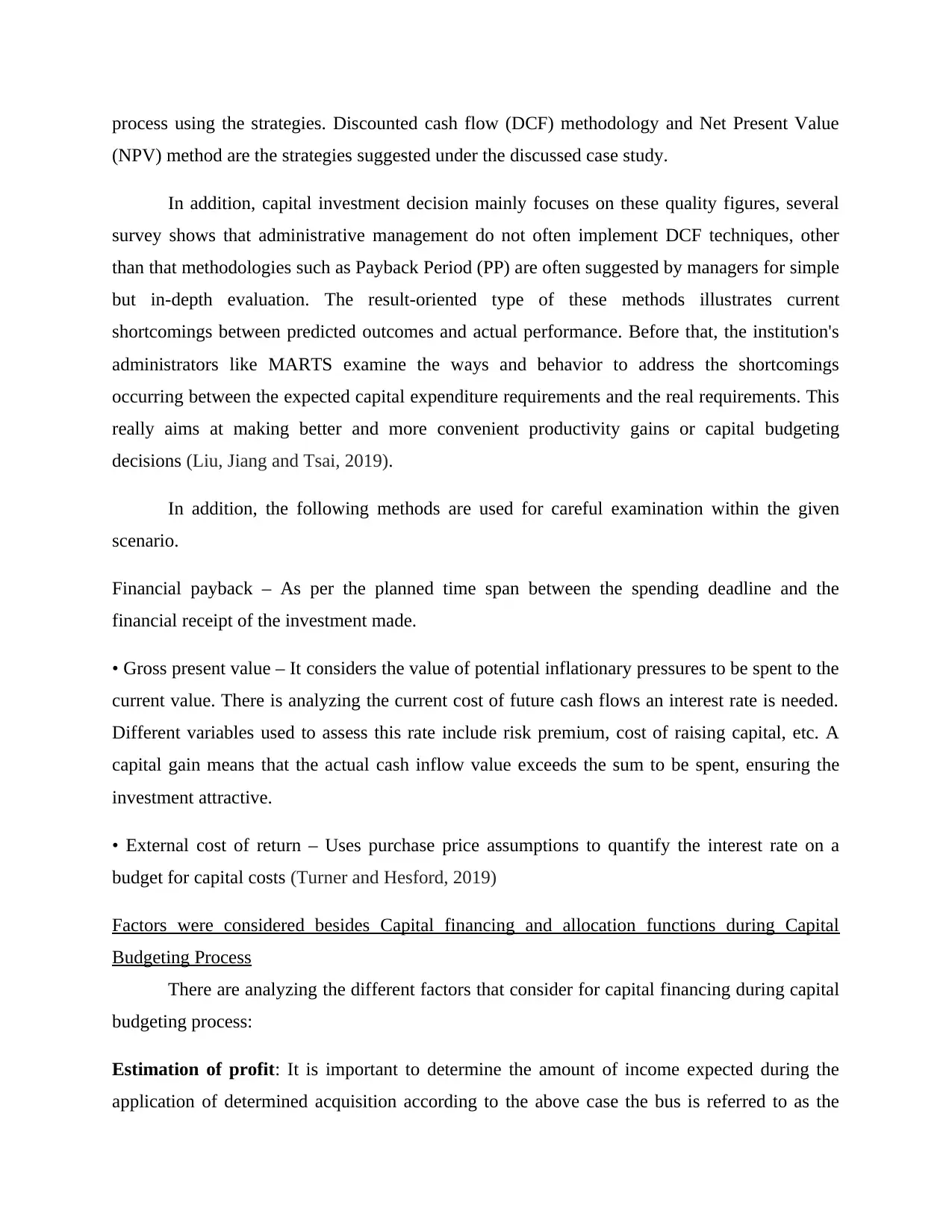
process using the strategies. Discounted cash flow (DCF) methodology and Net Present Value
(NPV) method are the strategies suggested under the discussed case study.
In addition, capital investment decision mainly focuses on these quality figures, several
survey shows that administrative management do not often implement DCF techniques, other
than that methodologies such as Payback Period (PP) are often suggested by managers for simple
but in-depth evaluation. The result-oriented type of these methods illustrates current
shortcomings between predicted outcomes and actual performance. Before that, the institution's
administrators like MARTS examine the ways and behavior to address the shortcomings
occurring between the expected capital expenditure requirements and the real requirements. This
really aims at making better and more convenient productivity gains or capital budgeting
decisions (Liu, Jiang and Tsai, 2019).
In addition, the following methods are used for careful examination within the given
scenario.
Financial payback – As per the planned time span between the spending deadline and the
financial receipt of the investment made.
• Gross present value – It considers the value of potential inflationary pressures to be spent to the
current value. There is analyzing the current cost of future cash flows an interest rate is needed.
Different variables used to assess this rate include risk premium, cost of raising capital, etc. A
capital gain means that the actual cash inflow value exceeds the sum to be spent, ensuring the
investment attractive.
• External cost of return – Uses purchase price assumptions to quantify the interest rate on a
budget for capital costs (Turner and Hesford, 2019)
Factors were considered besides Capital financing and allocation functions during Capital
Budgeting Process
There are analyzing the different factors that consider for capital financing during capital
budgeting process:
Estimation of profit: It is important to determine the amount of income expected during the
application of determined acquisition according to the above case the bus is referred to as the
(NPV) method are the strategies suggested under the discussed case study.
In addition, capital investment decision mainly focuses on these quality figures, several
survey shows that administrative management do not often implement DCF techniques, other
than that methodologies such as Payback Period (PP) are often suggested by managers for simple
but in-depth evaluation. The result-oriented type of these methods illustrates current
shortcomings between predicted outcomes and actual performance. Before that, the institution's
administrators like MARTS examine the ways and behavior to address the shortcomings
occurring between the expected capital expenditure requirements and the real requirements. This
really aims at making better and more convenient productivity gains or capital budgeting
decisions (Liu, Jiang and Tsai, 2019).
In addition, the following methods are used for careful examination within the given
scenario.
Financial payback – As per the planned time span between the spending deadline and the
financial receipt of the investment made.
• Gross present value – It considers the value of potential inflationary pressures to be spent to the
current value. There is analyzing the current cost of future cash flows an interest rate is needed.
Different variables used to assess this rate include risk premium, cost of raising capital, etc. A
capital gain means that the actual cash inflow value exceeds the sum to be spent, ensuring the
investment attractive.
• External cost of return – Uses purchase price assumptions to quantify the interest rate on a
budget for capital costs (Turner and Hesford, 2019)
Factors were considered besides Capital financing and allocation functions during Capital
Budgeting Process
There are analyzing the different factors that consider for capital financing during capital
budgeting process:
Estimation of profit: It is important to determine the amount of income expected during the
application of determined acquisition according to the above case the bus is referred to as the
⊘ This is a preview!⊘
Do you want full access?
Subscribe today to unlock all pages.

Trusted by 1+ million students worldwide
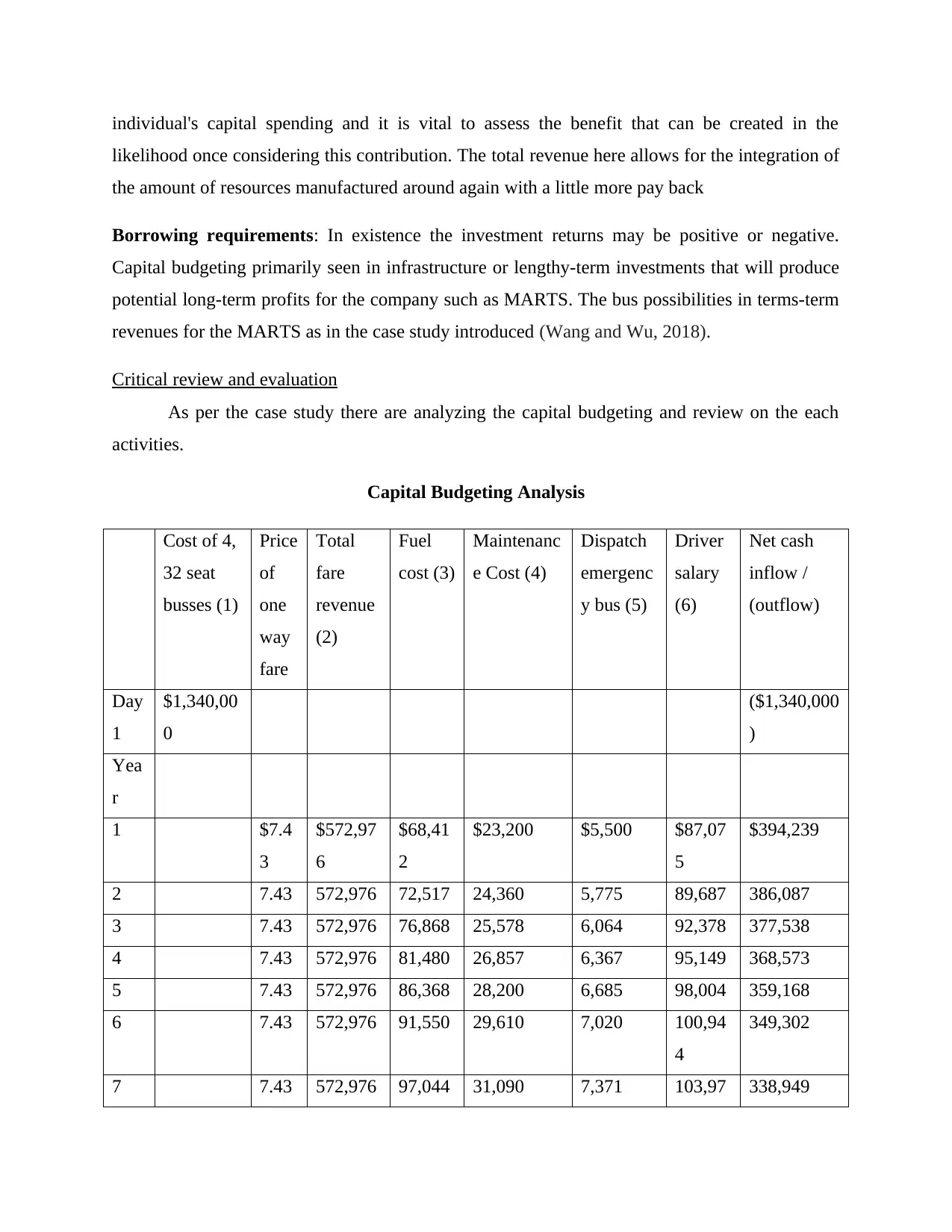
individual's capital spending and it is vital to assess the benefit that can be created in the
likelihood once considering this contribution. The total revenue here allows for the integration of
the amount of resources manufactured around again with a little more pay back
Borrowing requirements: In existence the investment returns may be positive or negative.
Capital budgeting primarily seen in infrastructure or lengthy-term investments that will produce
potential long-term profits for the company such as MARTS. The bus possibilities in terms-term
revenues for the MARTS as in the case study introduced (Wang and Wu, 2018).
Critical review and evaluation
As per the case study there are analyzing the capital budgeting and review on the each
activities.
Capital Budgeting Analysis
Cost of 4,
32 seat
busses (1)
Price
of
one
way
fare
Total
fare
revenue
(2)
Fuel
cost (3)
Maintenanc
e Cost (4)
Dispatch
emergenc
y bus (5)
Driver
salary
(6)
Net cash
inflow /
(outflow)
Day
1
$1,340,00
0
($1,340,000
)
Yea
r
1 $7.4
3
$572,97
6
$68,41
2
$23,200 $5,500 $87,07
5
$394,239
2 7.43 572,976 72,517 24,360 5,775 89,687 386,087
3 7.43 572,976 76,868 25,578 6,064 92,378 377,538
4 7.43 572,976 81,480 26,857 6,367 95,149 368,573
5 7.43 572,976 86,368 28,200 6,685 98,004 359,168
6 7.43 572,976 91,550 29,610 7,020 100,94
4
349,302
7 7.43 572,976 97,044 31,090 7,371 103,97 338,949
likelihood once considering this contribution. The total revenue here allows for the integration of
the amount of resources manufactured around again with a little more pay back
Borrowing requirements: In existence the investment returns may be positive or negative.
Capital budgeting primarily seen in infrastructure or lengthy-term investments that will produce
potential long-term profits for the company such as MARTS. The bus possibilities in terms-term
revenues for the MARTS as in the case study introduced (Wang and Wu, 2018).
Critical review and evaluation
As per the case study there are analyzing the capital budgeting and review on the each
activities.
Capital Budgeting Analysis
Cost of 4,
32 seat
busses (1)
Price
of
one
way
fare
Total
fare
revenue
(2)
Fuel
cost (3)
Maintenanc
e Cost (4)
Dispatch
emergenc
y bus (5)
Driver
salary
(6)
Net cash
inflow /
(outflow)
Day
1
$1,340,00
0
($1,340,000
)
Yea
r
1 $7.4
3
$572,97
6
$68,41
2
$23,200 $5,500 $87,07
5
$394,239
2 7.43 572,976 72,517 24,360 5,775 89,687 386,087
3 7.43 572,976 76,868 25,578 6,064 92,378 377,538
4 7.43 572,976 81,480 26,857 6,367 95,149 368,573
5 7.43 572,976 86,368 28,200 6,685 98,004 359,168
6 7.43 572,976 91,550 29,610 7,020 100,94
4
349,302
7 7.43 572,976 97,044 31,090 7,371 103,97 338,949
Paraphrase This Document
Need a fresh take? Get an instant paraphrase of this document with our AI Paraphraser
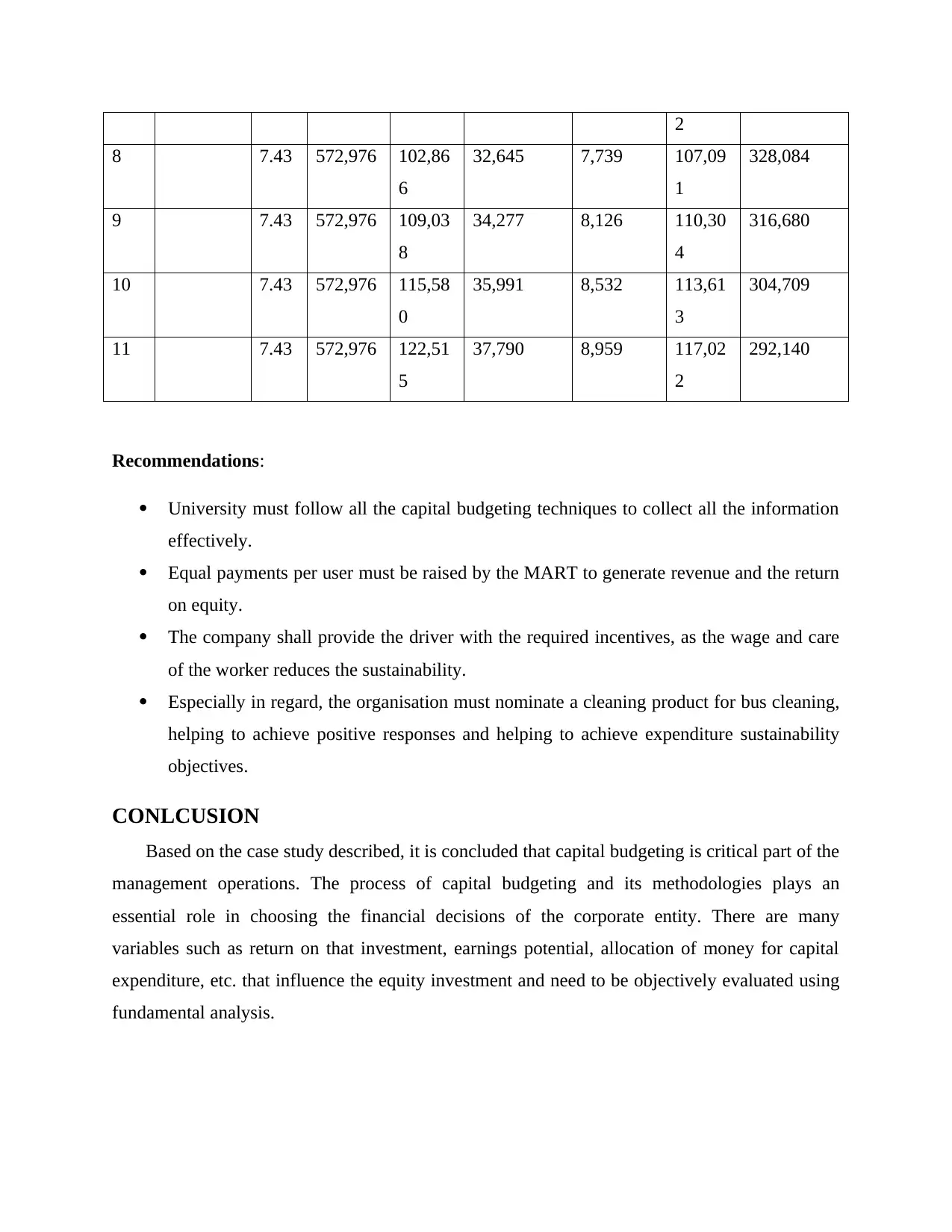
2
8 7.43 572,976 102,86
6
32,645 7,739 107,09
1
328,084
9 7.43 572,976 109,03
8
34,277 8,126 110,30
4
316,680
10 7.43 572,976 115,58
0
35,991 8,532 113,61
3
304,709
11 7.43 572,976 122,51
5
37,790 8,959 117,02
2
292,140
Recommendations:
University must follow all the capital budgeting techniques to collect all the information
effectively.
Equal payments per user must be raised by the MART to generate revenue and the return
on equity.
The company shall provide the driver with the required incentives, as the wage and care
of the worker reduces the sustainability.
Especially in regard, the organisation must nominate a cleaning product for bus cleaning,
helping to achieve positive responses and helping to achieve expenditure sustainability
objectives.
CONLCUSION
Based on the case study described, it is concluded that capital budgeting is critical part of the
management operations. The process of capital budgeting and its methodologies plays an
essential role in choosing the financial decisions of the corporate entity. There are many
variables such as return on that investment, earnings potential, allocation of money for capital
expenditure, etc. that influence the equity investment and need to be objectively evaluated using
fundamental analysis.
8 7.43 572,976 102,86
6
32,645 7,739 107,09
1
328,084
9 7.43 572,976 109,03
8
34,277 8,126 110,30
4
316,680
10 7.43 572,976 115,58
0
35,991 8,532 113,61
3
304,709
11 7.43 572,976 122,51
5
37,790 8,959 117,02
2
292,140
Recommendations:
University must follow all the capital budgeting techniques to collect all the information
effectively.
Equal payments per user must be raised by the MART to generate revenue and the return
on equity.
The company shall provide the driver with the required incentives, as the wage and care
of the worker reduces the sustainability.
Especially in regard, the organisation must nominate a cleaning product for bus cleaning,
helping to achieve positive responses and helping to achieve expenditure sustainability
objectives.
CONLCUSION
Based on the case study described, it is concluded that capital budgeting is critical part of the
management operations. The process of capital budgeting and its methodologies plays an
essential role in choosing the financial decisions of the corporate entity. There are many
variables such as return on that investment, earnings potential, allocation of money for capital
expenditure, etc. that influence the equity investment and need to be objectively evaluated using
fundamental analysis.
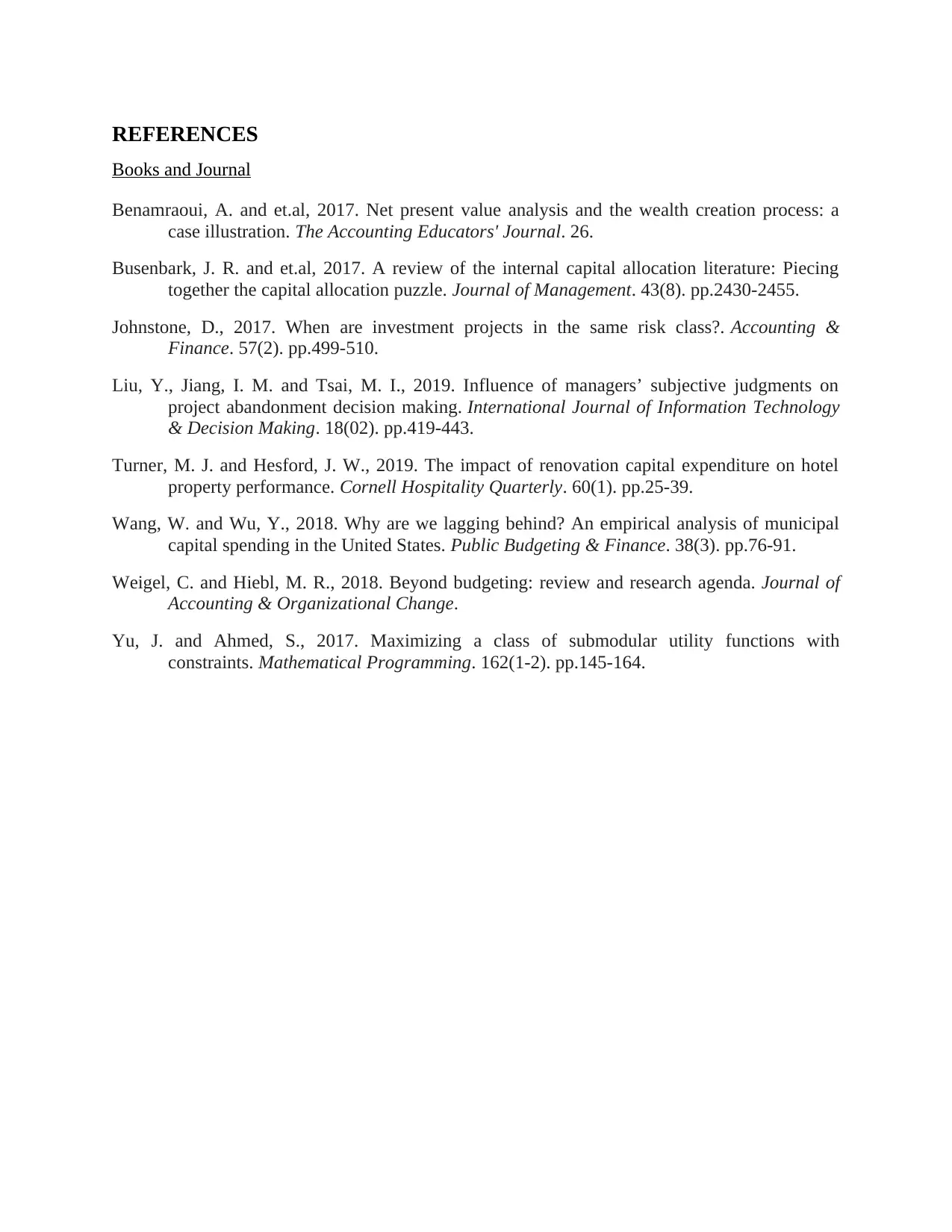
REFERENCES
Books and Journal
Benamraoui, A. and et.al, 2017. Net present value analysis and the wealth creation process: a
case illustration. The Accounting Educators' Journal. 26.
Busenbark, J. R. and et.al, 2017. A review of the internal capital allocation literature: Piecing
together the capital allocation puzzle. Journal of Management. 43(8). pp.2430-2455.
Johnstone, D., 2017. When are investment projects in the same risk class?. Accounting &
Finance. 57(2). pp.499-510.
Liu, Y., Jiang, I. M. and Tsai, M. I., 2019. Influence of managers’ subjective judgments on
project abandonment decision making. International Journal of Information Technology
& Decision Making. 18(02). pp.419-443.
Turner, M. J. and Hesford, J. W., 2019. The impact of renovation capital expenditure on hotel
property performance. Cornell Hospitality Quarterly. 60(1). pp.25-39.
Wang, W. and Wu, Y., 2018. Why are we lagging behind? An empirical analysis of municipal
capital spending in the United States. Public Budgeting & Finance. 38(3). pp.76-91.
Weigel, C. and Hiebl, M. R., 2018. Beyond budgeting: review and research agenda. Journal of
Accounting & Organizational Change.
Yu, J. and Ahmed, S., 2017. Maximizing a class of submodular utility functions with
constraints. Mathematical Programming. 162(1-2). pp.145-164.
Books and Journal
Benamraoui, A. and et.al, 2017. Net present value analysis and the wealth creation process: a
case illustration. The Accounting Educators' Journal. 26.
Busenbark, J. R. and et.al, 2017. A review of the internal capital allocation literature: Piecing
together the capital allocation puzzle. Journal of Management. 43(8). pp.2430-2455.
Johnstone, D., 2017. When are investment projects in the same risk class?. Accounting &
Finance. 57(2). pp.499-510.
Liu, Y., Jiang, I. M. and Tsai, M. I., 2019. Influence of managers’ subjective judgments on
project abandonment decision making. International Journal of Information Technology
& Decision Making. 18(02). pp.419-443.
Turner, M. J. and Hesford, J. W., 2019. The impact of renovation capital expenditure on hotel
property performance. Cornell Hospitality Quarterly. 60(1). pp.25-39.
Wang, W. and Wu, Y., 2018. Why are we lagging behind? An empirical analysis of municipal
capital spending in the United States. Public Budgeting & Finance. 38(3). pp.76-91.
Weigel, C. and Hiebl, M. R., 2018. Beyond budgeting: review and research agenda. Journal of
Accounting & Organizational Change.
Yu, J. and Ahmed, S., 2017. Maximizing a class of submodular utility functions with
constraints. Mathematical Programming. 162(1-2). pp.145-164.
⊘ This is a preview!⊘
Do you want full access?
Subscribe today to unlock all pages.

Trusted by 1+ million students worldwide
1 out of 9
Related Documents
Your All-in-One AI-Powered Toolkit for Academic Success.
+13062052269
info@desklib.com
Available 24*7 on WhatsApp / Email
![[object Object]](/_next/static/media/star-bottom.7253800d.svg)
Unlock your academic potential
Copyright © 2020–2025 A2Z Services. All Rights Reserved. Developed and managed by ZUCOL.



